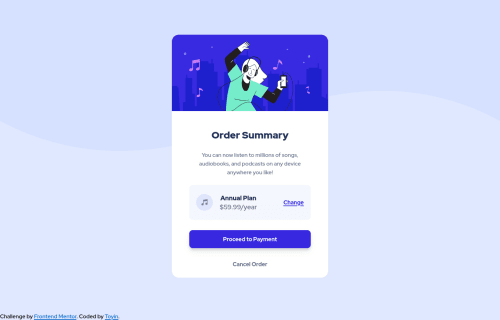Order summary using flexbox

Solution retrospective
Aligning my page was one of the biggest issues I faced
Please log in to post a comment
Log in with GitHubCommunity feedback
- @yterai
Your code looks neat and super clean! I'm gonna try that next time :)
- @maiaflow
Great work on this Toyin! It looks perfect! In your code, I like your semantic class names, I'm going to work on using those next time. Something else I want to try next time that we both didn't do is organizing your css into sections with commented out headers. Another one of those is deleting any commented out lines as a final clean up before submitting. Excited to see your next one!
- @ericsalvi
Hey Toyin,
Great job on your first submission. Checked out your code and it looks clean!
A few things I would try to do for your next challenges is to always check out the validation for accessibility or HTML. Either do this before you submit by using axe DevTools extension or you can check out the report that FrontendMentor generates here.
One thing I would suggest doing before you submit is to take all of your CSS and run it through a tool such as https://autoprefixer.github.io/. What it will do is generate any required additional CSS to make this submission work on all platforms and browsers. The best way to almost be fully compatible.
For your links instead of using
#for these types of components, I'd suggest usingjavascript:void(0)instead as this will not refresh the page when a link is clicked, unlike using#.Great work again and I cannot wait to see more of your work.
Keep up that momentum!
Join our Discord community
Join thousands of Frontend Mentor community members taking the challenges, sharing resources, helping each other, and chatting about all things front-end!
Join our Discord